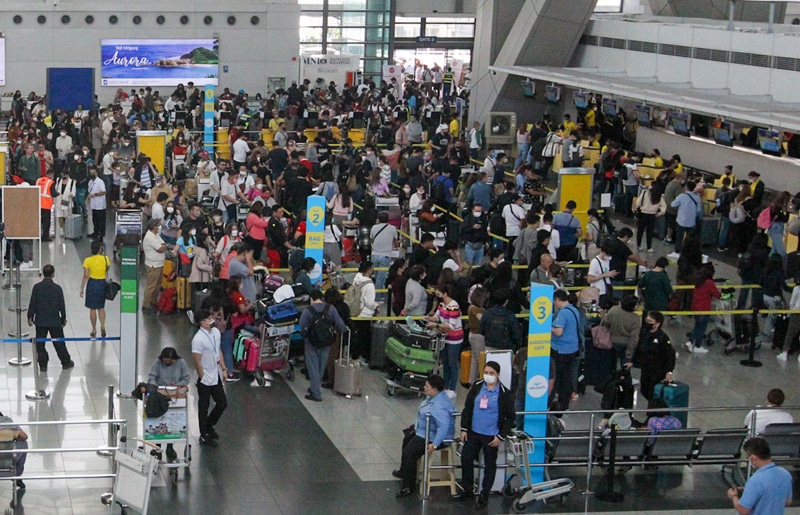The investigation of the technical glitch that led to the total shut-off of the Communication, Navigation and Surveillance/Air Traffic Management (CNS/ATM) system last January 1, 2023 by an independent body will be completed in two weeks, the Department of Transportation said.
Transportation Undersecretary for Aviation Roberto Lim said the investigating body is comprised of representatives from the DOTr, Department of Information and Communications Technology (DICT), Cybercrime Investigation and Coordinating Center (CICC), National Bureau of Investigation (NBI), and the National Intelligence Coordinating Agency (NICA).
Lim added that the Civil Aviation Authority of the Philippines (CAAP) inhibited from participating in the investigation.
The CAAP on Wednesday appealed to legislators to help the agency realize its plans to upgrade the country’s CNS/ATM System, including procurement of the Ultimate Fallback System.
The agency also asked the administration of President Ferdinand Marcos Jr. to designate a third party contractor to provide oversight on the operation and maintenance of the system.
The CAAP made these recommendations to improve its system and prevent a recurrence of the technical glitch that affected 300 flights and more than 60,000 passengers in Manila airport.
“We want to advise that there is an external investigating body or committee that has been organised and will lead the investigation of this incident. It is external because it is comprised of the DOTr, DICT, Cyber Investigation Crime Commission, NBI, NICA. You will note that CAAP is not part of this investigating committee,” Usec. Lim told members of the House Committee on Transportation.
Representatives of agencies have already visited the CNS/ATM site and have gathered relevant testimonies from personnel manning the critical system, Usec. Lim said.
“So far, [they] have visited the site. They inspected the relevant parts of the facility, they have interviewed people, testimonies from people directly involved in operating, manning and supervising the CNS/ATM,” he said, adding that a vulnerability test is being conducted on both the air traffic system and its equipment.
Lim said the investigation could take weeks before submitting the body’s findings and recommendations to the DoTr committee.
Meanwhile, CAAP Director General Manuel Antonio Tamayo said the agency already recommended the following enhancements: procurement of a multi-mode fallback system (system upgrade); construct an independent back-up CNS/ATM; and tap a third party contractor to provide oversight on the operation and maintenance of the system.
“To avoid this kind of circumstance recurring, we recommend the following plans for the CNS/ATM: restore and enhance to its original design before the incident, and procurement of the multi-mode fallback system which is considered a systems upgrade,” Tamayo said.
“[We are also looking at] the construction of an independent backup for CNS/ATM, and hiring of a third party contractor to provide oversight,” he added.
“It is true that any man made equipment can’t be 100% perfect all the time but we want the public to know that we shall do the best we can in order to provide an efficient service to our country and to the aviation sector,” he explained.
“Nevertheless, we will be needing the help and assistance of this honorable (House) committee in making these plans come into reality. This is of course to provide better service to our fellow Filipinos and our country, which may further boost our tourism industry,” he added.
Meanwhile, Tamayo also apologized for the confusion caused by several statements the CAAP has issued to explain the airport system breakdown.
“Please take note that it was never our intention to do so. The differences in the reports are due to our bid to be transparent to the public, that we provide updates to the media and other government agencies as they happen,” he said.
Tamayo said CAAP’s first assessment was a problem with the UPS (uninterruptible power supply) since it was not providing power to the equipment despite being active and receiving power from the source.
“[But] It was not until the engineers were able to determine that the probable cause of the disruption was the circuit breaker after a series of remedial measures, and evaluation,” he said.
“There were intervals in our official reports as our controllers, engineers, and technical staff were all working together to ensure the safety of all aircraft queued for landing and to quickly restore power without further damaging our vital equipment,” Tamayo added.
He explained that “the assessment, evaluation, and theories as to the probable cause of the disruption only came clear after the situation had normalized.”
“And as of this moment, we have identified that the probable causes of this ordeal are the damaged circuit breaker, and one of the equipment which was damaged – the Power Transfer Switch (PTS). Both items were turned-over to the CICC last January 09, 2023 for forensic investigation and examination to ensure impartiality,” he said.
Tamayo also said the “external investigation” being conducted by other government agencies is still ongoing.
“We would like to manifest that we take all of this as a lesson and we further manifest to this committee, and all those who were affected that we take full responsibility and accountability for what happened,” he added.





